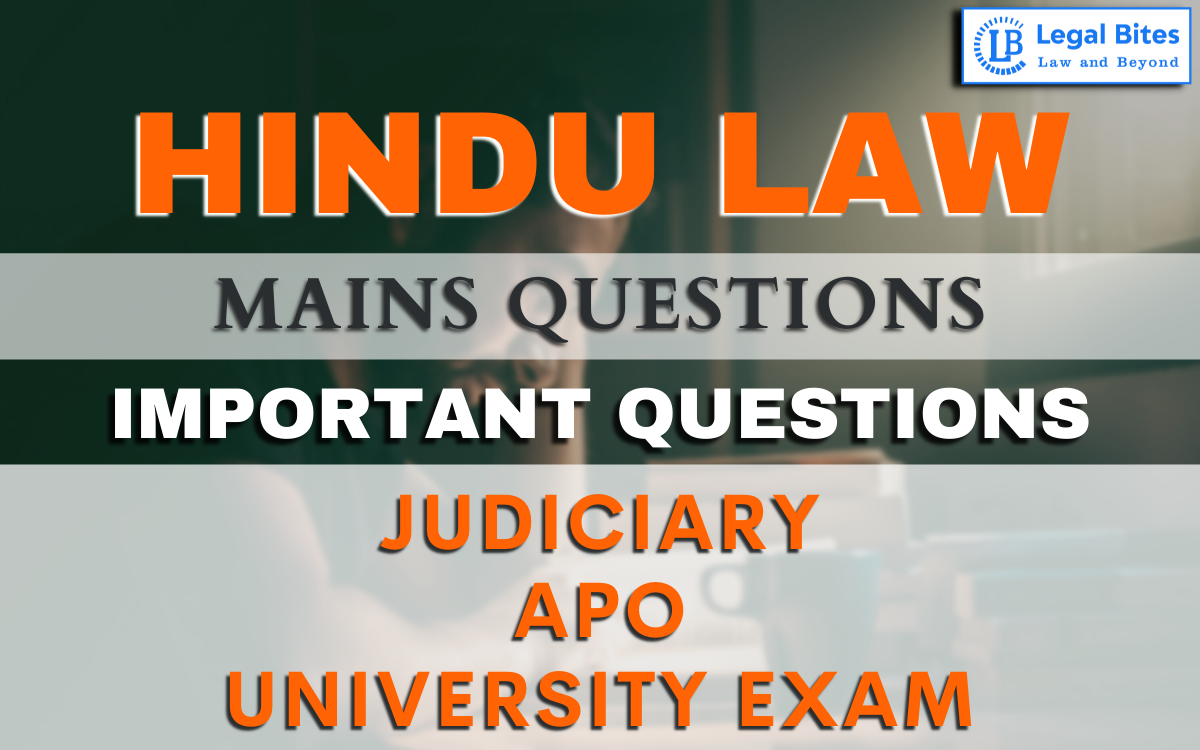Explain how coparcenary property is held in collective ownership by all the coparceners in a quasi-corporate capacity. State the incidents of coparcenary property with the help of an illustration.
Explain how coparcenary property is held in collective ownership by all the coparceners in a quasi-corporate capacity. State the incidents of coparcenary property with the help of an illustration.

Question: Explain how coparcenary property is held in collective ownership by all the coparceners in a quasi-corporate capacity. State the incidents of coparcenary property with the help of an illustration. [BJS 1977]Find the question and answer of Hindu Law only on Legal Bites. [Explain how coparcenary property is held in collective ownership by all the coparceners in a quasi-corporate capacity. State the incidents of coparcenary property with the help of an...
Question: Explain how coparcenary property is held in collective ownership by all the coparceners in a quasi-corporate capacity. State the incidents of coparcenary property with the help of an illustration. [BJS 1977]
Find the question and answer of Hindu Law only on Legal Bites. [Explain how coparcenary property is held in collective ownership by all the coparceners in a quasi-corporate capacity. State the incidents of coparcenary property with the help of an illustration.]
Answer
Coparcenary property means the property which consists of ancestral property and a coparcener would mean a person who shares equally with others inheritance in the estate of a common ancestor. Coparcenary is a narrower body than the joint family property.
Before the commencement of the Hindu Succession (Amendment) Act, 2005 only male members of the family used to acquire by birth an interest in the coparcenary, a coparcener has no definite share in the coparcenary property but he has an undivided interest in it and one has to bear in mind that it enlarges by deaths and diminishes by births in the family.
If the partition of an ancestral property remains in the hand of a single person, it has to be treated as separate property, and such a person shall be entitled to dispose of the coparcenary property, treating it to be his separate. But if a son is subsequently born, that moment a son is born the property becomes a coparcenary property and the son would acquire interest and become a coparcener.
In the case of Katama Natchiar v. The Raja of Shivagunga, [1863] 9 M.I.A. 539 (P.C.), it was held that the Joint family or coparcenary property is that in which every coparcener has a joint interest and a joint possession.
Under the Mitakshara School, the property of a Hindu Joint Family is held in collective ownership by all coparceners under a quasi-corporate capacity. The Mitakshara School lays down that the joint family property is held in trust for its members then living and thereafter being born.
Section 6 of the Hindu Succession Act, 2005 specifies that on and from the amendment of 2005, the daughter of a coparcener shall by birth become a coparcener, in her own right, in the same manner as the son.
Incidents of coparcenary property
The incidents of a coparcenary were summarised in the State Bank of India v. Ghamandi Ram, AIR 1969 SC 1330 of the Supreme Court.
The following are the main incidents of joint family or coparcenary property. It:
- devolves by survivorship, not by succession; this proposition must now be read in the context of sections 6 and 30 of the Hindu Succession Act, 1956, in cases where those sections are applicable;
- is the property in which the male and female issue (daughters) (after the amendment to the Hindu Succession Act, 2005) issue of the coparceners acquire an interest by birth.
The fundamental principle of a joint Hindu family is the tie of the sapinda-ship, without which it is impossible to form a joint Hindu family. As was held in the case of Karsandas v. Gangabai, (1908) 10 Bom LR 184. Joint family property is purely a creation of Hindu law, and those who own it are called coparceners.
The Supreme Court has summarized the position and observed that the coparcenary property is held in collective ownership by all the coparceners in a quasi-corporate capacity. The incidents of coparcenary are:
- The lineal male descendants of a person up to the third generation, acquire on birth ownership in the ancestral properties of such person;
- Such descendants can at any time work out their rights by asking for partition;
- Till partition each member has got ownership extending over the entire property conjointly enjoyment of the properties is common;
- As a result of such co-ownership the possession and enjoyment of the properties are common;
- No alienation of the property is possible unless it is for necessity, without the concurrence of the coparceners and;
- The interest of a deceased member passes on his death to the surviving coparceners.

Mayank Shekhar
Mayank is an alumnus of the prestigious Faculty of Law, Delhi University. Under his leadership, Legal Bites has been researching and developing resources through blogging, educational resources, competitions, and seminars.
